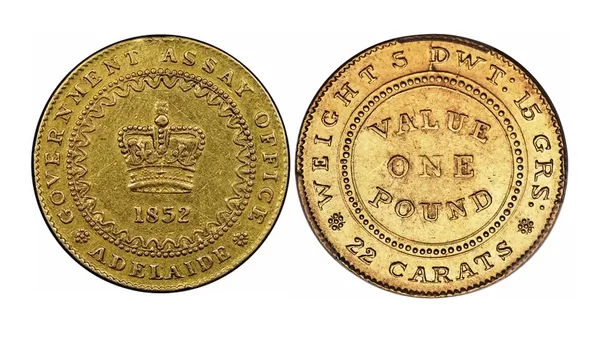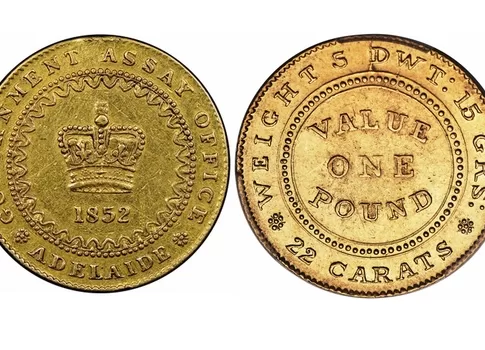The 1852 Adelaide Pound holds a special place in Australian history, being the nation’s first gold coin struck on Australian soil, directly from the nuggets & dust unearthed by the diggers in Ballarat & Bendigo.
Struck during the height of the gold rush, this coin not only symbolizes the wealth generated during that era but also represents a significant milestone in Australia’s numismatic history.
In this blog, we will delve into the origins, historical significance, value and unique characteristics of the 1852 Adelaide Pound, exploring why it remains a coveted item among collectors and investors today.
Advertisement:
Origins of the 1852 Adelaide Pound
The discovery of gold in Victoria and New South Wales in the early 1850s sparked a gold rush that drew prospectors from around the world.
South Australia, despite having goldfields of its own, faced an economic challenge as the colony’s population and wealth were rapidly being drawn to the eastern states. To combat this economic drain, South Australia decided to capitalize on its gold resources by minting its own gold coins.
In 1852, South Australian authorities commissioned the production of gold coins to provide a stable and reliable currency for the colony. The Adelaide Assay Office was established, and the Adelaide Pound was struck. Despite being minted without Royal Assent and thus technically illegal, the South Australian government commissioned these ingots to address the economic crisis. It was the first official gold coin minted in Australia and marked a significant step in the nation’s financial independence.
Historical Significance of the 1852 Adelaide Pound
The Adelaide Pound is not just a coin; it is a piece of Australian history. Its creation was a response to the economic pressures of the gold rush, reflecting the ingenuity and resilience of the South Australian colony. The coin also represents the early efforts of Australia to establish its own currency system, independent of British coinage.
Only about 25,000 Adelaide Pounds were minted, making them extremely rare. The coin’s limited mintage and historical significance have made it a highly sought-after item among numismatists and collectors.
Design and Characteristics
The design of the 1852 Adelaide Pound is both simple and elegant, embodying the craftsmanship of the era. The obverse features the inscription “Government Assay Office Adelaide” encircling a crown and the year “1852”, with the date “1852” -as shown below. The reverse side displays the words “Value One Pound” with “22 Carats Weight 5 DWT: 15GRS” surrounding it.

The coin was struck in 22-carat gold, with a diameter of approximately 22 millimeters and a weight of around 8.75 grams.
There are two types of Adelaide Pounds: the first type, known as the “Type I,” has a beaded inner circle on the reverse, while the “Type II” has a more refined, continuous inner circle.
The Type I is particularly rare and valuable due to its limited production and the fact that many were melted down for their gold content. All examples are quite rare, with just 20 of Type I in existence, and perhaps 200 Type II’s. Much sought after by collectors and investors.
The Type 1B reverse of these ingots, characterized by a beaded inner border between two linear circles and coarse edge reeding, is particularly rare. Out of a total recorded mintage of 24,648, less than 50 were produced with this reverse die, making it significantly scarcer than the more common crenulated variety introduced after an obverse die crack.
In the current certified population of these coins, Type 2 outnumbers Type 1 by a ratio of ten to one, with only three Type 1B ‘coarse reeding’ examples known at PCGS, compared to six Type 1A ‘fine reeding’ pieces.
Exceedingly Rare Type 1B 1852 Adelaide Pound available at Heritage Auctions.
Collecting the 1852 Adelaide Pound
For collectors, the 1852 Adelaide Pound is a prized addition to any numismatic collection. Its rarity, historical significance, and intrinsic gold value contribute to its high desirability. Owning an Adelaide Pound is akin to holding a tangible piece of Australia’s early colonial history.
The value of the Adelaide Pound has appreciated significantly over the years. Pristine examples can fetch substantial sums at auction, with prices often reaching into the hundreds of thousands of dollars. Factors such as the coin’s condition, type, and provenance can greatly influence its value.
The Adelaide Pound is rare in any grade and prices realised at auctions continue to rise dramatically, surpassing catalogue values. A very important early Australian numismatic heritage.
Investment Price History of the 1852 Adelaide Pound
| YEAR | COIN | GRADE | 1965 | 1999 | 2002 | 2004 | 2023 |
| 1852 | Type 1 Adelaide Pound | EF | $400 | $60,000 | $85,000 | $135,000 | $228,000 |
This 1852 “Adelaide” Pound, MS62 NGC sold for $228,000 in 2023.
As Australia’s first official gold coin, the 1852 Adelaide Pound holds immense historical and numismatic significance. Its story is a reminder of a pivotal time in Australia’s history, making it a cherished and enduring symbol of the nation’s golden era.
For collectors and investors, the Adelaide Pound represents a rare and valuable piece of Australia’s rich heritage, a reminder of early Australians during the gold rush era.
Whether you are a seasoned numismatist or a history enthusiast, the Adelaide Pound offers a fascinating glimpse into the past and a rewarding investment opportunity.
Further Reading
Pirate Guide to Collecting Australian Coins: 2023/2024 Edition, November 2, 2023 by Damian Walker
Renniks Australian Coin & Banknote Values 31st Edition Hardcover
A Guide Book of United States Coins 2022 75th Edition Spiral-bound by Garrett, Jeff, Bowers
Paper Money – North America – Australia – Oceania: COLOR PHOTOGRAPHY Paper money – Old and Rare Banknote (Banknotes of the world)
Related stories
Numismatics: Fake Coins to Watch For
Explore the Art of Belly Dancing
Police Ephemera ° The value of Victorian reward posters
‘Central Bank Digital Currency’ is a new digital form of money issued by RBA
What are the world’s largest and famous gold nuggets?
Advertisement:




